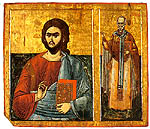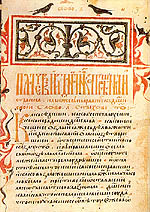
 |
  |
The
Patriarchate of Pec:
|
 |
|
The
treasury, icon of Christ with St. Nicholas, 1677
|
The Patriarchate of Pec had one of the richest treasuries in medieval Serbia. Serbian archbishops, and, later, patriarchs made generous gifts to the monastery in which they had their seat. Their example was followed by the rulers and the nobility, and, when the Turks came, contributions to the treasury came from church dignitaries and from craftsmen, merchants and Christian spahies. Such a collection of valuables attracted plunderers in times of insecurity or war, and, if preserved from them, it melted away in removals and transfers to hiding-places.
In spite of all these troubles, the Patriarchate of Pec has preserved a considerable number of manuscript books, icons, objects made of gold and embroidery, so that its collection, which is now housed in the Church of St. Demetrius, ranks among the richest in Serbia.
Among the icons exhibited in the treasury there are no works earlier than the 17th century, although each of the churches, built in the 13th and 14th centuries, must have had a number of icons.
 |
|
The
treasury, icon of saint healers Cosmas and Damian, with scenes from
their lives, 1674.
|
The icon of saints healers Cosmas and Damian, with the scenes of their miracles, is the most representative work of this kind in the treasury of Pec. A long inscription at the feet of the saints informs us that the icon was commissioned by monk Visarion, a nephew of Patriarch Maksim, and made in 1674. The decorative and narrative icon of the two saints healers, in a nicely painted and carved wooden frame, ranks not only among the best achievements of Radul, but also among the most attractive icons of the second half of the 17th century. Of less artistic value are the two icons painted by the same master in 1677, which originally formed a part of the iconostasis of the Church of St. Nicholas. One of them shows the Virgin and the other represents Christ with a full-length figure of St. Nicholas. Strong shades and routine workmanship spoil the general favourable impression of these icons.
 |
|
The
treasury, icon of St. george, with scenes from his life, early 17th
century
|
Also interesting is an icon of St. George with scenes illustrating his martyrdom, the work of an anonymous painter from the first half of the 17th century. This icon, too, is adorned, though not so lavishly, with gilded wood-carving. The large, greatly damaged icon of John the Forerunner, with scenes from his life, is also the work of this master. The icon representing the death of St. Sava of Serbia, the gift of Dorotej, a craftsman, dates from roughly the same period and shows the seven Maccabeans, a family of saints, on the reverse side.
Among the later icons, the icon of St. Petka with scenes from her life, presented in 1720 by Stojan, a furrier from Skopje, also deserves mention. Among the 18th and 19th century icons especially remarkable is the one with the figure of the Virgin, painted by Aleksije Lazovic in 1806 and made in imitation of the legendary work of St. Luke, the Evangelist.
A considerably damaged painted epitaphios dating from mid-14th century also belongs to the paintings preserved in the Pec treasury. The Lamentation of Christ is represented on linen in a very careful icon-painting technique. This is the earliest painted (not embroidered, as was customary) epitaphios, and it was found in the ruins of the episcopal Church of the Virgin of Hvosno near Pec. It is now exhibited on the north wall of the central bay in the Church of the Apostles.
Another epitaphios was excavated with this one; it bears an inscription which shows that it was made in 1597 and that its author was the Pec icon-painter Longin. It, too, shows the Lamentation of Christ, but it is not finished, for it was to be embroidered after this drawing.
 |
|
The
treasury, manuscript of the Dioptra, page with head-piece, early
15th century
|
A 15th century stole, part of clerical robes, is one of the most valuable pieces of embroidery in the Pec collection. Figures of saints, the Virgin and two angels are embroidered on it with gold and silver wire and silk threads of various colours. The noble drawing and the skill in matching colours make this stole a valuable item in the treasury.
The objects made of gold in the Pec collection date from the period of the Turkish rule only. There are a few vessels and book mountings from the 17th century, but these objects cannot be considered as important products of the art of that time. The 18th and 19th century works are considerably more representative. Several fine gilded crosses, with filigree decoration, are also wood-carving achievements: miniature wooden panels with the scenes of the Great Feasts and of the Passion are inserted along the arms of the cross. Only a few mountings of the 18th and 19-century manuscript books were made for the Patriarchate of Pec, for some of the earlier manuscripts reached the treasury as gifts. Thus the manuscript copy of the Gospels, transcribed in 1610 and adorned with fine mountings, was originally in the possession of the Monastery of St. Roman and reached the collection of the Patriarchate in the 18th century. The greater part of the mountings date from the 18th and 19th centuries; some of them were obtained as gifts from Russia, and their decoration is often influenced by the late Baroque. Among the panaghiarions - medallions worn round the neck - the earliest example is from 1650, originally the property of abbot Joanikije. Finely carved wooden rosettes are set into a frame made of silver and red semi-precious stone.
 |
|
The
treasury, bell, master Rodop, 1432
|
The small collection of objects not used in church service consists of very varied items. In includes silver cups, cases for knives and forks, inkpots, leather belts and metal belts. Some of the 18th and 19th century metalwork was made of precious materials. The metal belts, made of mother-of-pearl and silver, and frequently gilded, are the most valuable as works of art.
A special item in the Pec collection is an old bell, called Rodop's Bell, after the master who cast it. It belonged originally to the Church of St. Nicholas in the village of Banja, and the figure of that saint is cast on its lateral side. The big Rodop's Bell (55 x 72 cm) has a large and ornate inscription which gives the name of the master and the year of its making (1432).
The manuscript collection in the possession of the Patriarchate of Pec is considerable - it contains 113 items. They were acquired during the 18th and 19th centuries, and they include a number of manuscript books from earlier times, some of which are worthy of special notice either because of their age and historical value or because of their painted ornaments. The earliest item is a Gospel of St. Luke and St. John, a Serbian version written on vellum and dating from the 13th century. Although the manuscript has no other decoration apart from simple initials, it attracts attention because of the beauty of its nicely proportioned letters. Much more luxurious is the illumination of the mamanuscript known as the Dioptra, a theological and philosophical work by Michael Psellus, a Byzantine statesman of the 11th century. In addition to the initials, the manuscript has two head-pieces at the beginning, based on Byzantine traditions, with representations of birds and stylised plants. It dates from the first half of the 15th century, and the scribe's name seems to have been Radic. The so-called Romil's Gospel from the end of the 14th century also has fine painted ornaments. While the initials are rather simple, the seven head-pieces are much more complex and richer in colour.
They look rather archaic, so that it may be assumed that they were copied from an earlier model. The scribe, Romil, signed his name in secret letters in one place.
Of the manuscripts dating from the time after the coming of the Turks, the Four Gospels of scribe Simon from 1562 deserves mention. It was transcribed in the village of Ovcarevo and subsequently became the property of the Patriarchate. Its rustic and modest decoration testifies to the worsening conditions for the more ambitious undertakings in the field of art. All the books that have been mentioned so far are of Serbian origin. This is not the case with the Acts of the Apostles, which is listed as No. 20 in the Pec catalogue. It reached the treasury from west Russia, and dates from the beginning of the 16th century. Its lavish ornamentation - initials, head-pieces, tendrils on the margin, a small figure of St. Peter - is painted in gold and intense colours in the spirt of the late Gothic and, partly, early Renaissance art.
Finally, the rarities of the Pec treasury include a copy of the Octoichos, the earliest Cyrillic printed book in the Balkans, the printing of which was completed at Cetinje early in 1494. This book, the first product of the Serbian press, was commissioned by Durde Crnojevic, and the printer was a priest called Makarije.
History
/ People / Spirituality
/ Churches / Arts
/ Links
Main page / Serbian